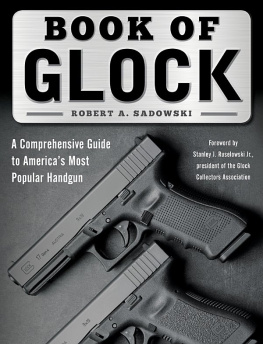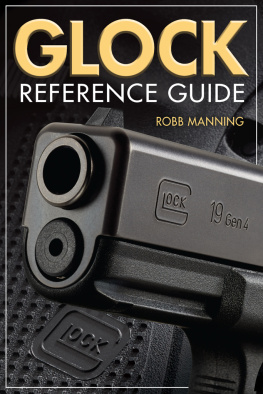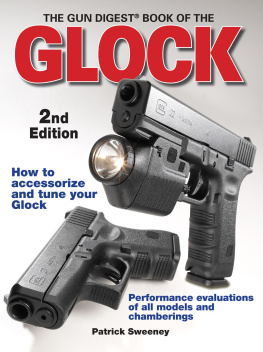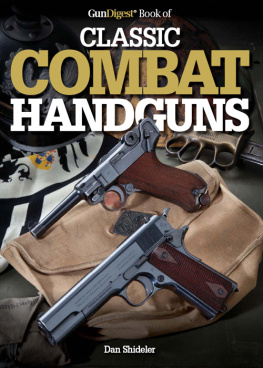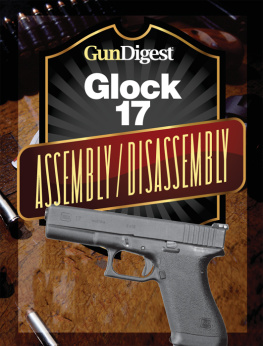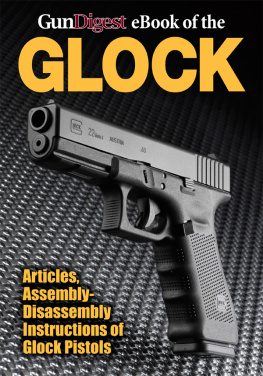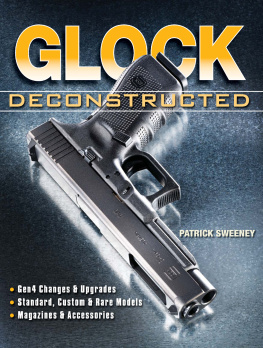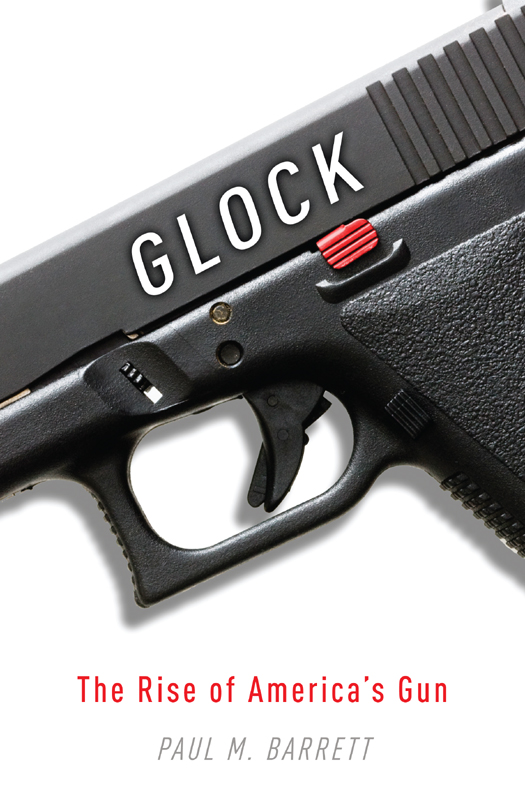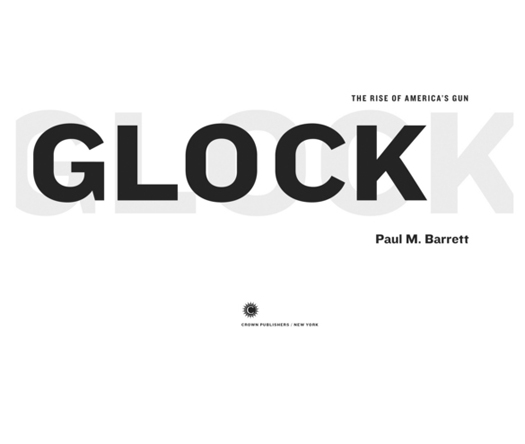Copyright 2012 by Paul M. Barrett
All rights reserved.
Published in the United States by Crown Publishers, an imprint of the Crown Publishing Group, a division of Random House, Inc., New York.
www.crownpublishing.com
CROWN and the Crown colophon are registered trademarks of Random House, Inc.
Library of Congress Cataloging-in-Publication Data
Barrett, Paul (Paul M.)
Glock : the rise of Americas gun / Paul M. Barrett.1st ed.
p. cm.
1. Glock GesellschaftHistory. 2. Glock pistolsHisotry. 3. Firearms and crimeUnited StatesHistory. 4. FirearmsUnited StatesUse in crime preventionHistory. I. Title.
HD9744.P584G563 2012
338.7683432509436dc23 2011024141
eISBN: 978-0-307-71994-2
Illustration by John Burgoyne
Jacket design by Whitney G. Cookman
Jacket photography Mike Kemp/Rubberball/Getty Images
v3.1
For Julie

Gaston Glock
Contents
CHAPTER 1
SHOOTOUT IN MIAMI
CHAPTER 2
PISTOL OF THE FUTURE
CHAPTER 3
ONE UGLY AND ALL-BUSINESS-LOOKING PIECE OF SELF-DEFENSE HARDWARE
CHAPTER 4
PLASTIC PERFECTION
CHAPTER 5
HIJACKERS SPECIAL
CHAPTER 6
SUPER GUN
CHAPTER 7
GOING HOLLYWOOD
CHAPTER 8
THE MARK OF CAIN
CHAPTER 9
COPY THE MOTHERFUCKER
CHAPTER 10
MASSACRE IN KILLEEN
CHAPTER 11
LAWYERS, GUNS, AND MONEY
CHAPTER 12
KA-BOOM
CHAPTER 13
POCKET ROCKETS
CHAPTER 14
MY WAY
CHAPTER 15
GLOCK CULTURE
CHAPTER 16
GLOCK GOES TO THE WHITE HOUSE
CHAPTER 17
AN ASSASSINS ATTACK
CHAPTER 18
MONOPOLY MONEY
CHAPTER 19
THE IMPACT OF THE AUSTRIAN PISTOL: GOOD FOR AMERICA?
CHAPTER 20
EPILOGUE
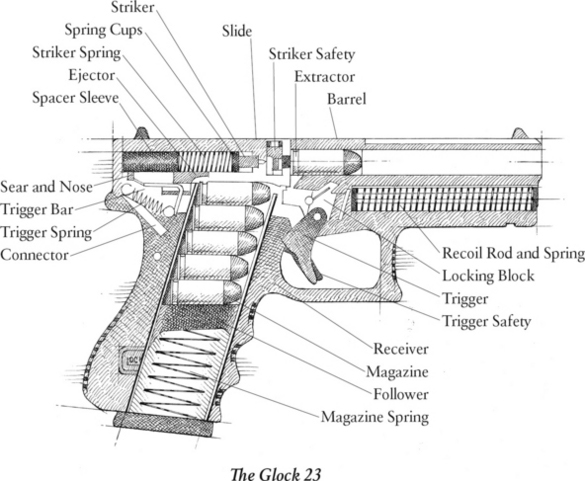
CHAPTER 1
Shootout in Miami
I t was nine forty-five a.m. on April 11, 1986, when Special Agents Benjamin Grogan and Gerald Dove spotted the two suspects driving a stolen black Chevrolet Monte Carlo on South Dixie Highway. The pair had been robbing banks and armored trucks in southern Dade County over the past four months. To catch them, Gordon McNeill, a supervisory special agent with the Miami field office of the Federal Bureau of Investigation, had set up a rolling stakeout. They had killed two people; another woman was missing, McNeill said. They had shot another guy four times. In my twenty-one years with the agency, I never felt more sure that when we found these guys, they would go down hard.
Moments later, other FBI units converged; soon, three unmarked sedans trailed the bank robbers. McNeill, closing from the opposite direction, spotted the black Monte Carlo at the head of the strange convoy. In the passenger seat, one suspect shoved a twenty-round magazine into a Ruger Mini-14 semiautomatic rifle. Felony car stop! McNeill shouted into his radio to the other units. Lets do it!
FBI vehicles corralled the Monte Carlo, ramming the fugitive automobile and forcing it into a large driveway. The three remaining government sedans skidded into surrounding positions. Two more FBI cars arrived across the street. In all, eight agents faced the two suspects.
Suddenly, one of the fugitives started shooting. FBI men scrambled for cover and returned fire. The occupants of the Monte Carlo seemed to be hit in the fusillade, but the government rounds werent stopping them.
In the chaos, the federal agents struggled to reload their revolvers, jamming cartridges one after another into five- and six-shot Smith & Wessons. Three of the FBI agents were members of a special-tactics squad and carried fifteen-round S&W pistols. But none of the handgun fire seemed to slow the criminals. The gunman with the Ruger Mini-14 merely had to snap a new magazine into his rifle to have another twenty rounds instantly. One of his mags had forty rounds. His partner had a twelve-gauge shotgun with extended eight-round capacity. The bank robbers were armed for a small war.
Agent McNeill took a round in his right hand, shattering bone. Shredded flesh jammed the cylinder of his revolver, making it impossible to reload. He rose from a crouch to reach for a shotgun on the backseat of an FBI vehicle. As he did, a .223 rifle round pierced his neck. He fell, paralyzed. A fellow agent was severely wounded when he paused to reload his Smith & Wesson Chiefs Special. Everybody went down fighting, McNeill said. We just ran into two kamikazes.
As law enforcement officials would later discover, the bank robbers, Michael Platt and William Matix, were no ordinary thugs. They had met in the 1970s at Fort Campbell, Kentucky. Matix served as a military policeman with the 101st Airborne. Platt received Special Forces training. Both were practiced marksmen. They operated a landscaping business and according to neighbors seemed like hardworking individuals. Neither one had a criminal record. But something had turned them into psychopaths.
Platt, demonstrating his deadly close-combat skills, worked the shoulder-fired Mini-14 with precision. Based on the M14 military rifle, the Mini-14 was popular with small-game hunters, target shooters, and, ironically, the police. Platt took full advantage of the semiautomatic weapons large magazine and penetrating ammunition. Bobbing and weaving, he sneaked up on Grogan and Dove, the agents who had originally spotted the black Monte Carlo. Hes coming behind you! another agent screamed. But the warning came too late. Platt fatally shot Grogan in the torso and Dove in the head.
The firefight had been going on for four minutes when Agent Edmundo Mireles, badly wounded, staggered toward Platt and Matix, who had piled into a bullet-ridden FBI Buick. A civilian witness described Mireless stiff-legged gait as stone walking. Holding a Smith & Wesson .357 Magnum at arms length, he fired repeatedly at the two gunmen at point-blank range, killing them both. It was the bloodiest day in FBI history.
All told, the combatants fired 140 rounds. In addition to the deaths of Platt and Matix, two FBI agents were killed, three were permanently crippled, and two others were injured. GUN BATTLE LOOKED LIKE OK CORRAL, the Palm Beach Post declared the next morning, quoting a shaken witness. But the legendary gunfight in 1881 in Tombstone, Arizona, had lasted only thirty seconds and involved just thirty shots, leaving three deadone fewer than the modern-day battle in Miami.

Lieutenant John H. Rutherford, the firing-range director with the Jacksonville Sheriffs Office, heard about the shootout later that day. The bad guys, he recalled, were starting to carry high-capacity weapons, unlike what they had carried in the past. That was a scary, terrible thing to hear about, he said. If the FBI is outgunned, something is wrong.




